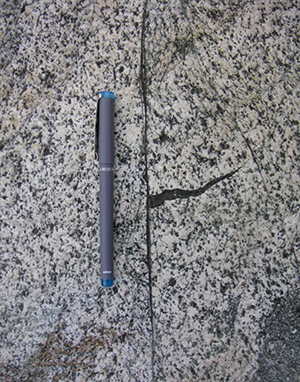| |||||||
|
|
|||||||
|
|
|||||||
| Supershear | |||||||
|
Supershear refers to very fast, spontaneously generated ruptures. Conceptually, mode II fractures, such as strike slip faults, propagate within two steady-state velocity regimes: either below the Rayleigh wave speed, called sub-Rayleigh, or between the S- and P-wave speeds, called supershear (Burridge, 1973; Andrews, 1976; Rosakis et al., 1999; Xia et al., 2004). Seismological observations suggest that supershear rupture propagations have occurred, at least locally, in several crustal scale strike-slip events, like the 1979 Imperial Valley earthquake (Archuleta, 1984), the 1999 Izmit and Duzce earthquakes (Bouchon et al., 2001), and the 2001 Kunlunshan earthquake (Bouchon and Vallee, 2003). Occurrence of melt, also referred to as psuedotachylyte, within and around faults (Figure 1) has been known for a long time (see for example, Swanson, 1988; Di Toro and Pennacchioni, 2004). These observations have recently been interpreted as a product of high velocity ruptures based on laboratory experiments (Griffith et al., 2009; Ngo et al., 2012) and mechanical models of plastic strain around high velocity ruptures (Dunham et al. 2011). Please see 'Mechanisms and Mechanics of Splay Joints.' | |||||||
| Reference: |
|||||||
| Andrews, D.J., 1976 Archuleta, R.J., 1984 Bouchon, M., Bouin, M.P., Karabulut, H., Toksoz, M.N., Dietrich, M., Rosakis, A.J., 2001 Bouchon, M., Vallee, M., 2003 Burridge, R., 1973 Di Toro, G., Pennacchioni, G., 2004 Dunham, E.M., Belanger, D., Cong, L., Kozdon, J.E., 2011b Griffith, W.A., Di Toro, G., Pennacchioni, G., Pollard, D.D., Nielsen, S., Ngo, D., Huang, Y., Rosakis, A.J., Griffith, A.A., Pollard, D.D., 2012 Rosakis, A.J., Samudrala, O., Coker, D., 1999 Swanson, M.T., 1988 Xia, Rosakis, A.J., Kanamori, H., 2004 |
|||||||
|
Readme | About Us | Acknowledgement | How to Cite | Terms of Use | Ⓒ Rock Fracture Knowledgebase |
|||||||
